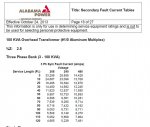It is certainly possible the 54 K is legit, but IMO not likely. Very roughly and generally, you will see utility transformer KVA 40-50% of NEC service KVA, so 3x112.5's is quite unlikely. Getting the actual Z can give you a better deal. As I said thats what I did. I told the utility engineer/designer that number seemed way high could he get me actual transformer data. He said sure and went out to the yard and snapped a pic of the actual unit they were going to use.
they will not use the actual s
they use the lowest in their inventory that may be used as a replacement
if I supply the xfmr I would use its pu z
if the util supplies it and states in their terms of service (as pg&e does) they will provide the sc value, that is what I would use
I will not assume the liability of reducing it to save the client some $$ up front and expose him to a possible issue in the future
I would explore the options of mitigating it/reducing magnitude


